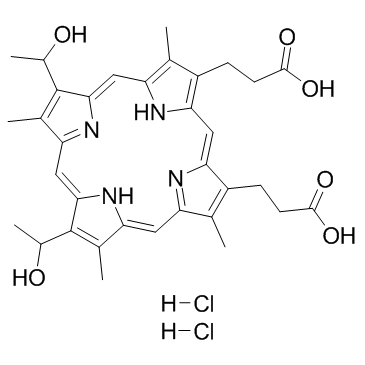Hematoporphyrin (dihydrochloride)
Modify Date: 2025-08-21 10:08:13

Hematoporphyrin (dihydrochloride) structure
|
Common Name | Hematoporphyrin (dihydrochloride) | ||
|---|---|---|---|---|
| CAS Number | 17696-69-4 | Molecular Weight | 671.611 | |
| Density | N/A | Boiling Point | 1192.7ºC at 760 mmHg | |
| Molecular Formula | C34H40Cl2N4O6 | Melting Point | N/A | |
| MSDS | N/A | Flash Point | 675.1ºC | |
Use of Hematoporphyrin (dihydrochloride)Hematoporphyrin dihydrochloride is a substrate for affinity chromatography of heme-binding proteins.Target: OthersHematoporphyrin is used for affinity chromatography of heme-binding proteins. Hematoporphyrin is used in the characterization and synthesis of hematoporphyrin- and hematin-agarose [1]. |
| Name | Hematoporphyrin IX dihydrochloride,8,13-Bis(1-hydroxyethyl)-3,7,12,17-tetramethyl-21H,23H-porphine-2,18-dipropionic acid dihydrochloride |
|---|---|
| Synonym | More Synonyms |
| Description | Hematoporphyrin dihydrochloride is a substrate for affinity chromatography of heme-binding proteins.Target: OthersHematoporphyrin is used for affinity chromatography of heme-binding proteins. Hematoporphyrin is used in the characterization and synthesis of hematoporphyrin- and hematin-agarose [1]. |
|---|---|
| Related Catalog | |
| References |
| Boiling Point | 1192.7ºC at 760 mmHg |
|---|---|
| Molecular Formula | C34H40Cl2N4O6 |
| Molecular Weight | 671.611 |
| Flash Point | 675.1ºC |
| Exact Mass | 670.232483 |
| PSA | 171.36000 |
| LogP | 4.24970 |
| Vapour Pressure | 0mmHg at 25°C |
| InChIKey | DZEVQAVOSKHDRL-UHFFFAOYSA-N |
| SMILES | CC1=C(CCC(=O)O)c2cc3[nH]c(cc4nc(cc5[nH]c(cc1n2)c(C(C)O)c5C)C(C(C)O)=C4C)c(C)c3CCC(=O)O.Cl.Cl |
| Storage condition | 2-8°C |
| Water Solubility | Insoluble in water. Soluble in pyridine (5%). |
|
Section 1: Product Identification Chemical Name:Hematoporphyrin IX dihydrochloride CAS Registry Number:17696-69-4 Formula:C34H38N4O6.2HCl EINECS Number:241-699-4 Chemical Family:porphine (porphyrin) ligand Synonym:none
Section 2: Composition and Information on Ingredients IngredientCAS NumberPercentACGIH (TWA)OSHA (PEL) Title Compound17696-69-4100%no datano data Section 3: Hazards Identification Emergency Overview:No particular hazard associated with this material. Primary Routes of Exposure:Ingestion, inhalation Eye Contact:May cause slight to mild irritation of the eyes. Skin Contact:May cause slight to mild irritation of the skin. Inhalation:May be irritating to the nose, mucous membranes and respiratory tract. Ingestion:No specific information is available on the physiological effects of ingestion. Acute Health Affects:May be irritating to skin, eyes and respiratory tract. Chronic Health Affects:No information available on long-term chronic effects. NTP:No IARC:No OSHA:No SECTION 4: First Aid Measures Immediately flush the eyes with copious amounts of water for at least 10-15 minutes. A victim may need Eye Exposure: assistance in keeping their eye lids open. Get immediate medical attention. Wash the affected area with water. Remove contaminated clothes if necessary. Seek medical assistance if Skin Exposure: irritation persists. Remove the victim to fresh air. Closely monitor the victim for signs of respiratory problems, such as difficulty Inhalation: in breathing, coughing, wheezing, or pain. In such cases seek immediate medical assistance. Seek medical attention immediately. Keep the victim calm. Give the victim water (only if conscious). Induce Ingestion: vomiting only if directed by medical personnel. SECTION 5: Fire Fighting Measures Flash Point:no data Autoignition Temperature:none Explosion Limits:none Extinguishing Medium:carbon dioxide, dry powder or foam If this material is involved in a fire, fire fighters should be equipped with a NIOSH approved, positive pressure Special Fire Fighting Procedures: self contained breathing apparatus and full protective clothing. Hazardous Combustion andIf involved in a fire this material may emit toxic organic fumes. Decomposion Products: Unusual Fire or Explosion Hazards: No unusual fire or explosion hazards. SECTION 6: Accidental Release Measures Spill and Leak Procedures:Small spills can be mixed with vermiculite or sodium carbonate and swept up. SECTION 7: Handling and Storage Handling and Storage:Store in a tightly sealed container. Keep away from heat and direct sunlight. SECTION 8: Exposure Controls and Personal Protection Eye Protection:Always wear approved safety glasses when handling a chemical substance in the laboratory. Skin Protection:Wear protective clothing and gloves. Ventilation:Material may form a fine dust. If possible, handle the material in an efficient fume hood. If ventilation is not available a respirator should be worn. The use of respirators requires a Respirator Respirator: Protection Program to be in compliance with 29 CFR 1910.134. Ventilation:Material may form a fine dust. If possible, handle the material in an efficient fume hood. Additional Protection:No additional protection required. SECTION 9: Physical and Chemical Properties Color and Form:purple xtl. Molecular Weight:671.62 Melting Point:no data Boiling Point:no data Vapor Pressure:no data Specific Gravity:no data Odor:none Solubility in Water:insoluble SECTION 10: Stability and Reactivity Stability:air and moisture stable solid Hazardous Polymerization:no hazardous polymerization Conditions to Avoid:none Incompatibility:oxidizing agents Decomposition Products:carbon dioxide, carbon monoxide, nitrogen oxides, and organic fumes SECTION 11: Toxicological Information Oral (rat); LD50: >3 gm/kg. Intraperitoneal (rat); LD50: 278 mg/kg. Oral (mouse); LD50: >1300 mg/kg. RTECS Data: Intraperitoneal (mouse); LD50: 169 mg/kg. Carcinogenic Effects:No data available Mutagenic Effects:No data available Tetratogenic Effects:No data available SECTION 12: Ecological Information Ecological Information:No information available SECTION 13: Disposal Considerations Disposal:Dispose of according to local, state and federal regulations. SECTION 14: Transportation Shipping Name (CFR):Non-hazardous Hazard Class (CFR):NA Additional Hazard Class (CFR):NA Packaging Group (CFR):NA UN ID Number (CFR):NA Shipping Name (IATA):Non-hazardous Hazard Class (IATA):NA Additional Hazard Class (IATA):NA Packaging Group (IATA):NA UN ID Number (IATA):NA SECTION 15: Regulatory Information TSCA:Listed in the TSCA inventory. SARA (Title 313):Not reportable under SARA Title 313 Second Ingredient:none SECTION 16 - ADDITIONAL INFORMATION N/A |
CHEMICAL IDENTIFICATION
HEALTH HAZARD DATAACUTE TOXICITY DATA
|
| Risk Phrases | R33 |
|---|---|
| RTECS | TS5505000 |
| MFCD00013470 |
| 21H,23H-Porphine-2,18-dipropanoic acid, 7,12-bis(1-hydroxyethyl)-3,8,13,17-tetramethyl-, hydrochloride (1:2) |
| HEMATOPORPHYRIN DIHYDROCHLORIDE |
| EINECS 241-699-4 |
| 3,3'-[7,12-bis(1-hydroxyethyl)-3,8,13,17-tetramethylporphyrin-2,18-diyl]dipropanoic acid dihydrochloride |
| 3,3'-[7,12-Bis(1-hydroxyethyl)-3,8,13,17-tetramethyl-2,18-porphyrindiyl]dipropanoic acid dihydrochloride |
| HAEMATOPORPHYRIN DIHYDROCHLORIDE |
| acido1,3,5,8-tetrametil-2,4-bis(idrossietil)porpfina-6,7-dipropionicodiclor |
| Hematoporphyrin (dihydrochloride) |

